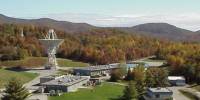
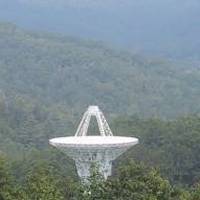
Amateur Pulsar Observations
P. Ibelings, N4IP
M. Wheatley, AE4JY
The Idea
Pulsars have always been a fascinating topic but seemed to be limited to the realm of professional radio astronomers due to the large antennas required and specialized receivers and computing resources. While working on the RFSpace SDR-14 digital spectrum analyzer/receiver hardware (http://www.rfspace.com ), it occured to us that it may be possible to capture pulsars using this hardware platform.
Pulsar signals are narrow(in time) RF bursts that occur at very stable periods ranging from seconds to milliseconds depending on the particular pulsar. The RF burst is spread out over a wide frequency range from MHz to GHz with the maximum energy occuring in different frequency ranges depending again on the particular pulsar. To make matters worse, most pulsar signals experiance frequency dispersion in which the higher frequency components arrive earlier than the low frequency components.( MathCADModel) A Google search will return a wealth of links to pulsars from the basics to mind numbing papers on the physics of pulsars.
The SDR-14 hardware is able to capture up to 262144 baseband complex samples in its internal FIFO memory at sample rates up to around 4MHz. The stock hardware/software begins filling the FIFO with commands from the PC host software after the previous capture has been transmitted back to the PC on a USB 1.1 data link. This leaves undetermined time spaces between block captures.
The idea was to modify the SDR-14 hardware to allow an external trigger signal to be used to begin each block capture at precisely the same rate as the Pulsar frequency. This would allow us to then process each block "in phase" with the pulsar period and average and integrate with the pulse position remaining stationary in time.
Sync scheme figure---Sync Scheme
Modifying an SDR-14 to add an external sync signal was relatively easy and modifying SpectraVue to display Power versus Time was done in a few days as well as building and testing the Pulsar sync generator. A GPS locked 10 MHz reference was input into a PTS-160 frequency generator that had a native resolution of .1Hz. By running the generator at a higher frequency and adding an external divider, a resolution of < 1uHz was obtained.
Block diagram of proposed pulsar capture hardware---Block Diagram
Now all we needed was a BIG antenna !!
The Antenna
A radio astronomy facility is located a few hours north of Atlanta GA up in the hills of North Carolina at the Pisgah Astronomical Research Institute. ( http://www.pari.edu/ ) They have a couple of 26m dishes, one of which is on 327MHz for pulsar work. PARI's president, Don Cline, and the technical director, Charles Osborne, K4CSO, graciously allowed us to drag our equipment to their facility and try and see some pulsars


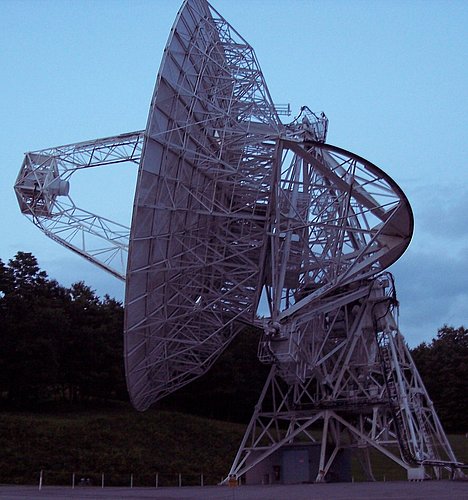
The Cast and Crew
Besides ourselves, several crucial team members were involved to pull off this adventure:
The PARI Trip July 8-10, 2005
We arrived late morning on July 8th, 2005 and spent the rest of the afternoon setting up, hunting down some spurs, and creating a plan of action.

The PARI Main control console
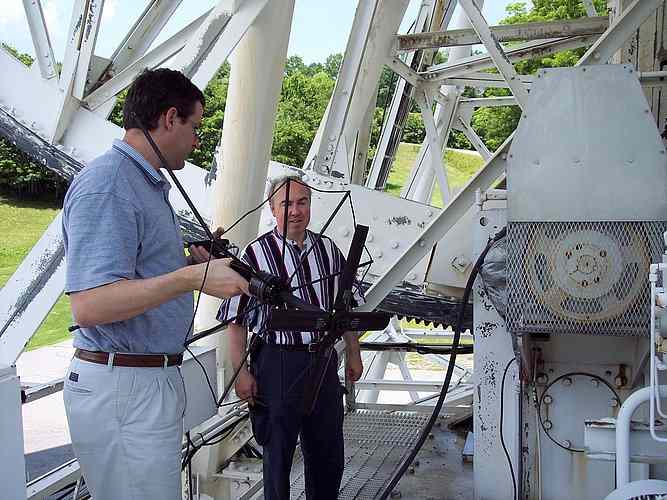
Pieter and Charles tracking down some birdies on 327 MHz
Here is the overall block diagram of the Pulsar detection system-- Block Diagram
The Results...
We attempted to see the following pulsars..
Initially we did not have the program TEMPO up and running so we did a "back of the envelope" calculation of the pulsar periods based on published models and just the first derivative of the period and no doppler correction. Against sound advice, we proceded to try and see the crab pulsar with eager anticipation of giant pulses and cheers from the crowd. We were snubbed by the universe with a line of incoherent noise.
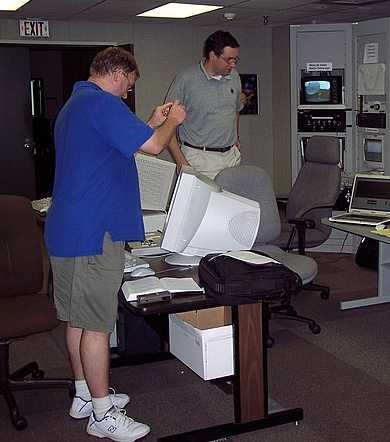
David trying Voodoo to get TEMPO to run while Pieter waits for a giant pulse to appear
Humbled but not defeated, we then took the advice and tuned in B0329+54, a slower and less dispersed pulsar. At around 6:20 PM local time on July 8, 2005 we were rewarded with a waterfall display of our first pulsar(a little off frequency but still beautiful)..
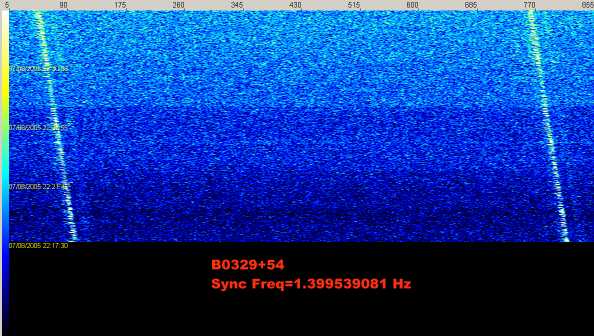
David and Lamar were still trying to get TEMPO program running so we could get accurate frequency predictions but we found that by measuring the slope of the waterfall trace, we could get close enough to start doing some folding and averaging of the pulses for some nice integrated and smoothed pulse profiles.
SIngle pulse with averaging and smoothing(showing off the small secondary humps).. B0329_54_SingleAvePulse.png and pB0329+54_wf.gif
We recorded data and played with various settings until our friend B0329+54 sank below the trees. The rest of the evening was spent unsucessfully looking for a few other pulsars and trying to get TEMPO running. We decided to wait up till 3:30 AM for B0329+54 to appear again to ease our fears that our original sigthing was not a fluke. Fortunately it reappeared and we could get a few hours sleep while David stayed up till who knows how late to get TEMPO running.
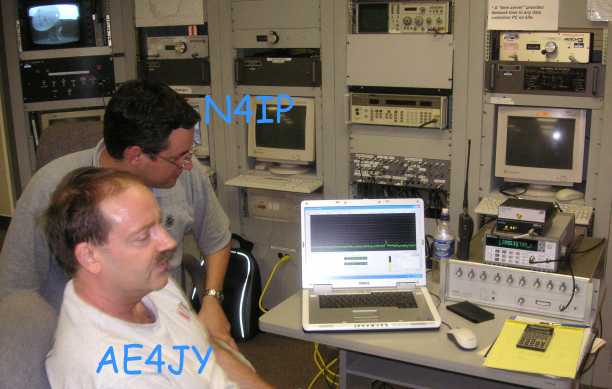
Moe and Pieter after 3 hours sleep
July 9, 2005 we were up mid morning to find some more pulsars. David had TEMPO up and running and was able to spit out pulsar frequencies and positions and we were in business. We discovered the waterfall plot was a good way to initially see a pulsar and adjust position on the screen before kicking in the averaging to get a good pulse shape. Also, getting two consecutive pulses on the screen allowed easy verification of the pulsar rate.
We were able to see B0950+08 and B01133+16.
B0950+08 Waterfall..B0950_08_WF.png and pB0950+08.gif
B0950+08 2D Averaged ..B0950_08_2D.png
B1133+16 Waterfall..B1133_16_WF.png
B1133+16 2D Averaged (Note 2 humped pulse shape)..B1133_16_SingleAve.png and pB1133+16.gif
An attemp was made to see the strong Vela Pulsar B0833-45 which just barely appears for a few minutes over the southern sky every day. Unfortunately, the antenna did not manage to reach low enough plus there was a hill in the way so the mission was scrubbed.
Basking in success, we spent the rest of the day touring the PARI facility, getting surprised by a 4 foot black snake, and using their log periodic HF antenna on top of the mountain to get some good wide spectral captures of the entire 30MHz HF band. 10 meters was even open so there were signals across the entire spectrum.
Our Nemesis.. B0531+21
Not seeing the Crab Pulsar which was our original prime directive, nagged at us so we pointed the antenna at it again on July 10, 2005 and captured data at several bandwidths in hopes that later processing would be able to bring something out. We left PARI that morning and headed home with a disk full of noise and hopefully a little energy from B0531+21.
Several days were spent trying different averaging settings but no sign of a pulse was found in any of the captured data. With the help of Joe, K1JT's code example and a stack of papers gleaned from the Internet, a coherent de-dispersion algorithm was implemented in the modified SpectraVue program. Again no amount of averaging would develop a pulse from the stubborn Crab Pulsar. Finaly giving up with my head overloaded with convolution and complex inverse Fourier transforms, I began cleaning up some files to at least show off the pulsars that we did see.
While looking at one of the waterfall displays of the Crab pulsar with the new de-dispersion code activated, I noticed some fairly bright streaks that appeared random in position so were assumed to be just random impulse noise. On a separate waterfall of the same data where the de-dispersion was not active, the bright streaks were missing. Hmmmm. Even when the de-dispersion value was just slightly off from the value for the Crab pulsar(56.79), the streaks would disappear.
B0531+21 Waterfall with No de-dispersion..CrabWF_NoDeDisp.png
B0531+21 Waterfall with correct DM=56.79 de-dispersion..CrabWF_DM56_791.png
B0531+21 Waterfall with incorrect DM=50.0 de-dispersion..CrabWF_DM50.png
B0531+21 Waterfall with incorrect DM=60.0 de-dispersion..CrabWF_DM60.png
Armed with this compelling evidence, a careful search in the data stream found a pair of unaveraged pulses that had exactly the correct period for B0531+21. Although not a spectacular success, the crab pulsar was finally found.
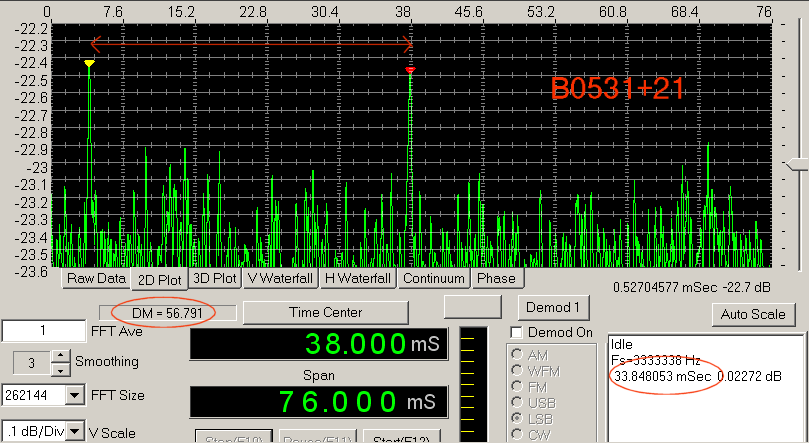
What We Learned..
What's Next ?
Although the pulsars were observed by amateurs using simple hardware, the antenna system was hardly amateur. The next step will be to try and capture pulsars using antenna systems in reach of us mere mortals. With the de-dispersion code working and a much clearer knowledge of what to look for, we hope to use a local ham's EME array on 432 MHz in August, to capture some of natures more interesting RF sources.
Stay Tuned....